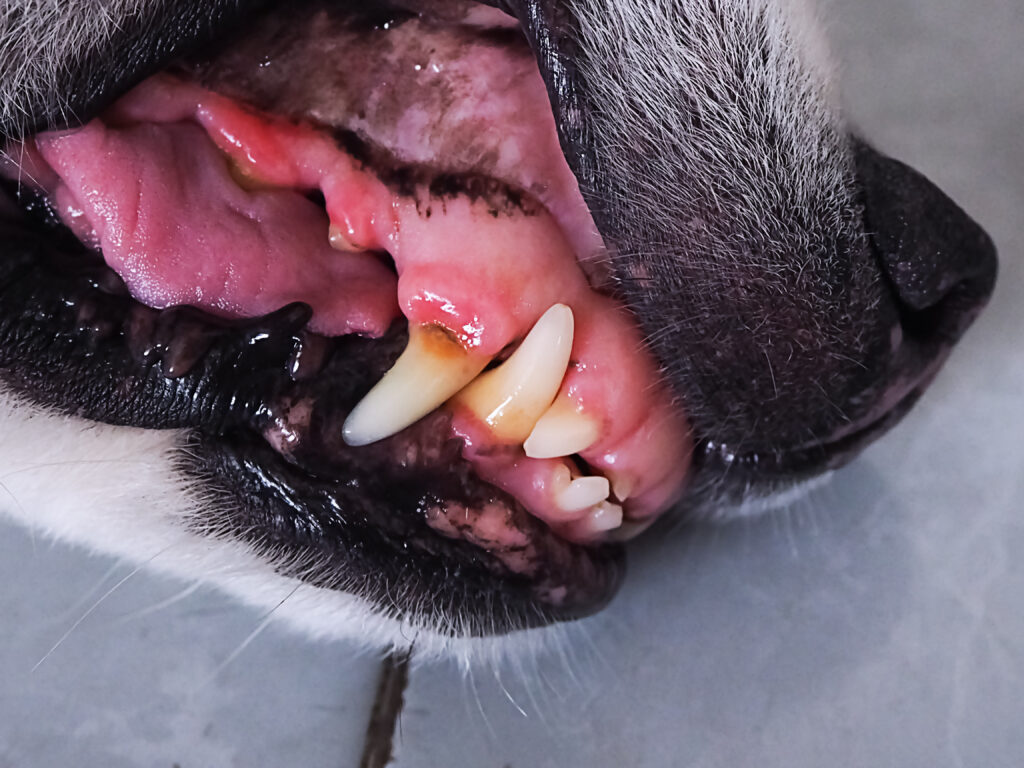Taking care of our beloved dogs involves more than just providing them with food, love, and a cozy place to sleep. One aspect of canine care that’s often overlooked is dental health. This blog is dedicated to shedding light on dental disease in dogs, a common condition that is often taken for granted.
We’ll explore the various signs and symptoms of dental disease in dogs, emphasizing the importance of routine dental care and regular veterinary exams. If you’re concerned about your dog’s dental health, Boulder Veterinary Hospital in Boulder, CO, is here to help. For more information or to schedule an appointment, please call us at (303) 442-6262.
Understanding Dental Disease in Dogs
Dental disease in dogs, often known as periodontal disease, is not just a single condition but a progression of several dental issues. It starts with the buildup of plaque on the teeth. Plaque, a sticky film composed of bacteria, can harden into tartar if it is not removed. This leads to gingivitis, an inflammation of the gums, characterized by redness and swelling. If left unchecked, this can advance to periodontitis, where the infection spreads deeper, affecting the tooth’s supporting structures. This progression can result in tooth loss, pain, and even systemic health problems as bacteria enter the bloodstream.
Periodontal disease is the most common clinical condition occurring in adult dogs. By the age of three, most dogs show some signs of dental disease. Unfortunately, it often goes unnoticed because many dogs continue to eat and play normally despite having oral discomfort. Regular pet dental checkups are crucial for early detection and management of this condition. Additionally, understanding the risk factors, such as breed, age, and general health, can help in preventing the onset of dental diseases in dogs.
Common Symptoms of Dental Disease to Look Out For
Recognizing the signs of dental disease in dogs early is key to preventing more serious health problems. Here are some common symptoms:
Bad Breath
While it’s common for dogs not to have perfectly fresh breath, a persistent, strong odor is a telltale sign of dental disease. This is often the result of bacteria accumulation in the mouth.
Red or Swollen Gums
Gingivitis causes the gums to become red, swollen, and sometimes bleed. This is often painful for your dog and can lead to more serious conditions if not treated.
Difficulty Eating
Dental pain can make eating a challenging task for your dog. They might eat slower, chew only on one side of their mouth, drop food, or even refuse to eat altogether.
Excessive Drooling
Increased drooling, especially when it’s tinged with blood, can indicate oral discomfort or dental disease.
Loose or Missing Teeth
Advanced dental disease can lead to tooth mobility or loss. This not only affects your dog’s ability to eat but can also lead to infections.
Pawing at the Mouth
If your dog frequently paws at their mouth or rubs their face against surfaces, it might be a response to dental pain or discomfort.
Changes in Behavior
Dental pain can lead to changes in your dog’s behavior. They might become more irritable, less playful, or show a decrease in appetite.
Preventive Measures for Dental Disease
While professional care is essential, there are steps you can take at home to keep your dog’s teeth and gums clean and healthy:
Choose the Right Diet
Feeding your dog a balanced diet can help them maintain good dental health. Some dog foods are specifically formulated to reduce plaque and tartar buildup.
Regular Brushing
Brushing your dog’s teeth regularly can significantly reduce their risk of dental disease. There are toothbrushes and toothpaste on the market specially designed for dogs.
Dental Treats and Toys
Dental treats and toys can help you clean your dog’s teeth and reduce plaque buildup. However, these should not replace regular teeth brushing or veterinary care.
The Importance of Regular Dental Care
Not keeping up with your dog’s dental health can lead to severe problems like bacterial infections, abscesses, tooth loss, and chronic oral pain. What’s more, an infection of the mouth can eventually become an infection of the major organs if bacteria under your pet’s gums find their way into the bloodstream. Regular brushing and oral exams at Boulder Veterinary Hospital are necessary to prevent dental disease in your dog.
Dental disease in dogs is a common but preventable condition. By being aware of the symptoms and the importance of regular dental care, you can ensure your dog stays happy and healthy. Remember, if you have any concerns about your dog’s dental health, don’t hesitate to contact Boulder Veterinary Hospital at (303) 442-6262 for advice or to schedule an appointment.





